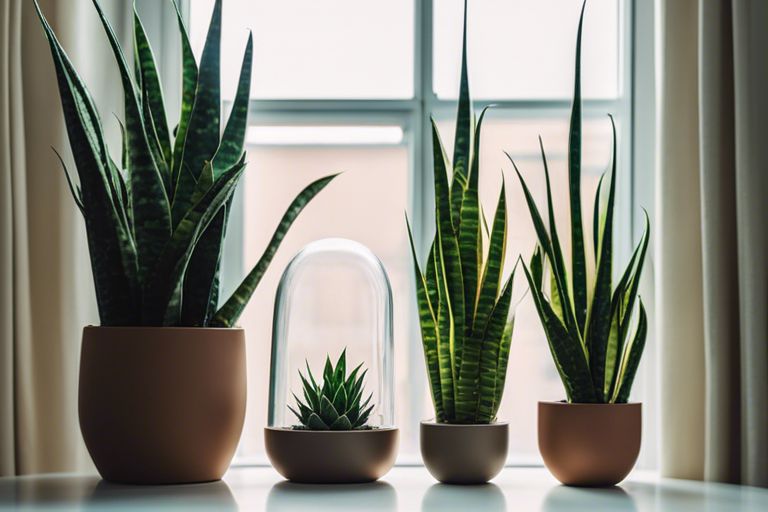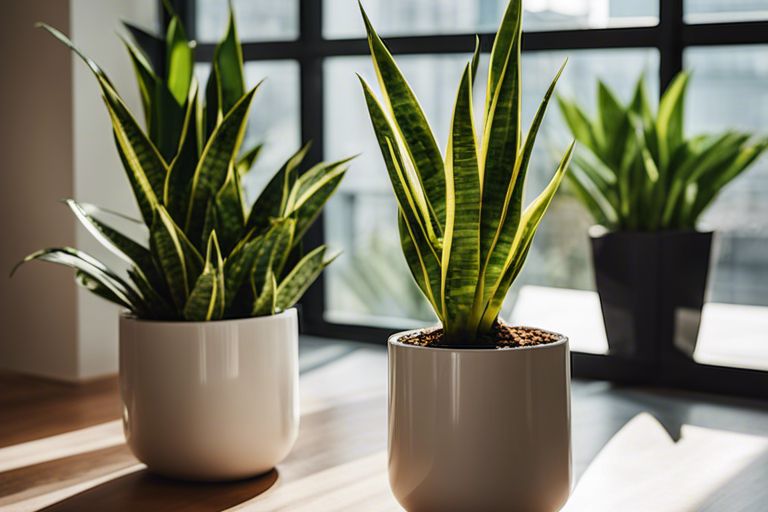Over the years, snake plants have gained popularity among indoor plant enthusiasts due to their low maintenance requirements and air-purifying qualities. These plants, also known as Sansevieria, are resilient, drought-tolerant, and adaptable to various light conditions, making them ideal for both novice and experienced plant owners.
Whether you lack a green thumb or simply have a busy schedule, snake plants are a great addition to any indoor space. In this blog post, we will explore the care tips and tricks that make these plants so easy to maintain, allowing you to enjoy the beauty of nature without the stress of high-maintenance plants.

Key Takeaways:
- Low maintenance plant: Snake plants are extremely easy to care for and require minimal attention, making them a perfect choice for beginner or busy plant owners.
- Adaptability: These plants can thrive in various conditions, including low light and infrequent watering, making them versatile and resilient indoor plants.
- Health benefits: Snake plants not only beautify indoor spaces but also help improve air quality by removing toxins, making them a valuable addition to any home or office.

The Origin and Characteristics of Snake Plants
There’s something intriguing about the Snake Plant, also known as Sansevieria or Mother-in-law’s Tongue. This popular houseplant has a rich history and a host of characteristics that make it a favorite among plant enthusiasts.
History and Background
Plants belonging to the Sansevieria genus are native to West Africa, Madagascar, and southern Asia. They have been cultivated for centuries for their air-purifying qualities and low-maintenance nature. The Snake Plant gets its name from its long, pointed leaves that resemble a snake’s skin.
Varieties and Physical Features
Physical characteristics of Snake Plants can vary widely depending on the variety. Some have tall, slender leaves while others are short and compact. The leaves may have different patterns like stripes, spots, or solid colors. Despite these differences, all Snake Plants share one common trait – they are incredibly resilient and require minimal care.
To add to their appeal, Snake Plants come in various sizes, making them suitable for different spaces in your home. Whether you have a large living room or a small office desk, there’s a Snake Plant variety that can thrive in your environment.
Understanding Snake Plant Care Basics
Keep your snake plant thriving by understanding the basic care requirements. For a comprehensive guide, check out the Black Gold Snake Plant Care Guide: Expert Tips & Tricks to ensure your plant stays healthy and vibrant.
Ideal Environmental Conditions
For optimal growth, snake plants require well-draining soil and a suitable container. These plants prefer temperatures ranging from 60-80°F (15-27°C) and are adaptable to various humidity levels. However, snake plants thrive in environments with moderate humidity levels.
Light Requirements
Ideal light conditions for snake plants include bright, indirect sunlight. They can also tolerate low light conditions, making them perfect for offices or rooms with minimal natural light. Plants with insufficient light may become leggy or lose their variegation, while those exposed to direct sunlight for extended periods can suffer from sunburn.
The best practice is to place your snake plant near a window with sheer curtains or provide artificial light if natural light is limited. Rotate the plant periodically to promote even growth and prevent it from leaning towards the light source.
Watering Your Snake Plant
Despite their reputation for being low-maintenance, knowing how to properly water your snake plant is key to ensuring its health and longevity. Overwatering is one of the most common mistakes that plant owners make, as this can lead to root rot and eventually kill the plant. On the other hand, neglecting to water your snake plant can also have detrimental effects. Finding the right balance is crucial for keeping your snake plant thriving.
How Often to Water
For snake plants, it’s important to remember that less is more when it comes to watering. These plants are drought-resistant and can survive with minimal water. A good rule of thumb is to water your snake plant every 2-6 weeks, depending on factors such as humidity levels, sunlight exposure, and the size of the pot. Before watering, always check the moisture level of the soil to avoid overwatering.
Signs of Overwatering and Underwatering
With snake plants, it’s crucial to pay attention to the signs of overwatering and underwatering. Signs of overwatering include yellowing leaves, mushy stems, and a foul odor emanating from the soil. On the other hand, signs of underwatering may include dry, crispy leaves and drooping foliage. Adjust your watering schedule accordingly based on these visual cues to keep your snake plant healthy and happy.
Snake plants are resilient and forgiving, so if you do happen to overwater or underwater them, there is still hope for recovery. Trim off any yellow or mushy leaves and adjust your watering routine to give your plant a chance to bounce back. Note, it’s always better to underwater than overwater your snake plant to prevent irreversible damage.
Soil and Potting Essentials
Once again, when it comes to caring for snake plants, having the right soil and potting imperatives is crucial. By ensuring that your plant has the proper growing medium and pot, you can help it thrive and grow beautifully indoors.
Suitable Soil Mixtures
One of the reasons why snake plants are easy to care for is because they are not too picky about their soil. These plants can thrive in a variety of soil mixtures, as long as they have good drainage. A popular and effective option is to use a well-draining succulent or cactus mix, which helps prevent the plant’s roots from sitting in water, ultimately avoiding root rot.
The Right Pot: Size and Material
Material
To ensure the health and growth of your snake plant, it is important to choose the right pot size and material. With respect to material, terra cotta pots are an excellent choice for snake plants as they allow for proper airflow and moisture regulation. Additionally, terra cotta pots are sturdy and help prevent the plant from becoming waterlogged, which is a common issue with snake plants.

Fertilizing and Growth Management
When and How to Fertilize
After purchasing your snake plant, it’s important to understand that fertilizing is not always necessary for its growth. These hardy plants can thrive even with minimal feeding. However, if you want to promote faster growth and healthier foliage, you can consider fertilizing your snake plant. An important thing to remember is to only fertilize during the growing season, which is typically from spring to summer.
Pruning and Propagation Techniques
The pruning and propagation techniques for snake plants are relatively simple, making them an excellent choice for beginner plant enthusiasts. The key to keeping your snake plant healthy through pruning is to remove any yellow or damaged leaves with sterile shears. Additionally, if you want to propagate your snake plant, you can do so by dividing the rhizomes or leaf cuttings. This process is not only straightforward but can also help you expand your plant collection without having to spend extra money.
Fertilize your snake plant sparingly, as excessive feeding can actually do more harm than good. Use a well-balanced liquid fertilizer diluted to half strength and apply it to the soil every 4-6 weeks during the growing season. Keep in mind, less is more when it comes to fertilizing your snake plant for optimal growth and health.
Troubleshooting Common Issues
Pest and Disease Prevention
Not properly addressing pest and disease issues can quickly turn a thriving snake plant into a wilting mess. The best way to prevent these problems is to maintain good plant hygiene. Keeping your snake plant clean by wiping the leaves with a damp cloth can help ward off pests like spider mites or mealybugs.
The soil should also be well-draining to prevent root rot, a common issue in snake plants. Watering sparingly and ensuring the pot has proper drainage holes can help avoid water accumulation in the roots which can lead to rotting.
Dealing with Common Problems
Issues like overwatering, underwatering, or exposure to extreme temperatures can cause distress to your snake plant. Problems like yellowing leaves, mushy stems, or stunted growth are signs that something is amiss. When faced with such symptoms, it is crucial to assess the plant’s environment and adjust care accordingly.
Dealing with Common Problems requires patience and observation. If you suspect overwatering, allow the soil to dry out before watering again. If underwatering is the issue, gradually increase watering frequency. Moving the plant to a location with more consistent temperature and light levels can also help revive a struggling snake plant.
Enhancing Your Snake Plant’s Potential
Decorative Potting Tips
Unlike other plants, Snake Plants do not require frequent repotting. However, giving your Snake Plant a decorative pot can enhance its overall aesthetic appeal. When choosing a pot, opt for one that is slightly larger than the plant’s current container to allow room for growth. Make sure the pot has drainage holes to prevent waterlogging. Repot your Snake Plant every 2-3 years to refresh the soil and provide it with new nutrients.
- Snake Plants thrive in well-draining soil mixtures
- Choose a pot that complements your interior decor
- Repot every 2-3 years to promote healthy growth
Perceiving your Snake Plant as not just a plant, but as a piece of decorative art, can bring a sense of creativity and style to your indoor space. By applying these decorative potting tips, you can elevate the appearance of your Snake Plant and make it a focal point in your home or office.
Creating Optimal Display Settings
Creating optimal display settings for your Snake Plant involves considering its lighting and positioning. Place your Snake Plant in indirect sunlight for best growth results. Avoid direct sunlight as it can scorch the leaves. Choose a location that has good air circulation to prevent any fungal diseases. Using a humidifier or occasionally misting the plant can help maintain the ideal indoor climate for your Snake Plant.
Potting your Snake Plant in a container with proper drainage can prevent root rot and waterlogging, both of which can be detrimental to the plant’s health. Additionally, ensuring the plant has enough space in the pot to grow its roots will promote healthier development. By creating optimal display settings for your Snake Plant, you can maintain its beauty and vigor for years to come.
Final Words
Now that you have a deeper understanding of how to care for snake plants, you can confidently add this popular indoor plant to your collection. With their low maintenance needs and ability to thrive in a variety of environments, snake plants truly simplify indoor plant care for beginners and seasoned plant parents alike. By providing the right conditions of adequate sunlight, well-draining soil, and minimal watering, you can enjoy the beauty and air-purifying benefits of snake plants with ease.
Remember to periodically check for signs of overwatering or underwatering, and adjust your care routine accordingly. With a little attention to detail and a willingness to learn, you can cultivate a thriving snake plant that enhances your living space and brings a touch of nature indoors. Embrace the simplicity of snake plant care and watch as your green thumb flourishes!
